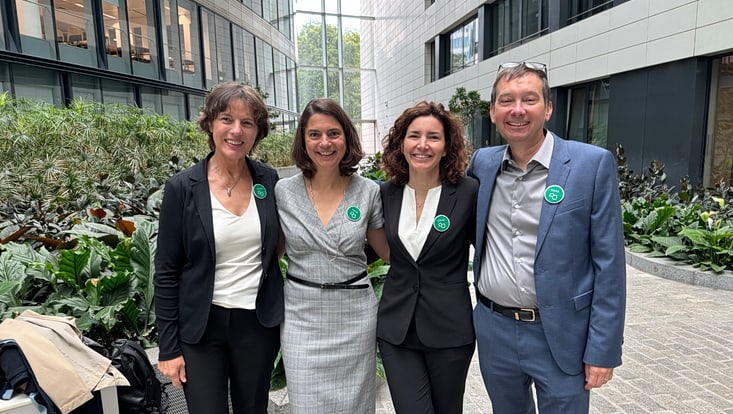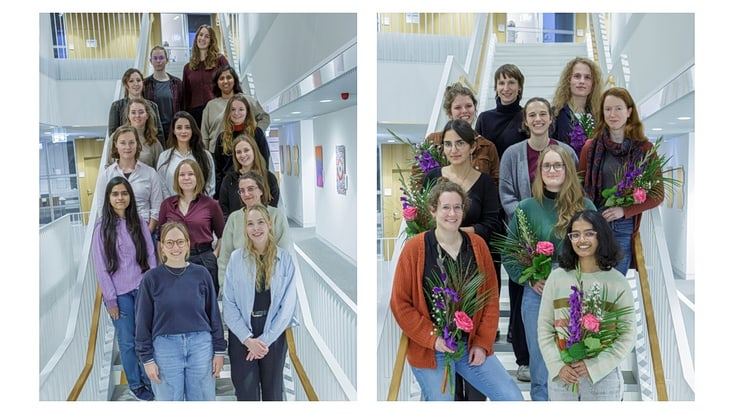Imaging of Matter
The Fascination of Science
19 June 2019

Photo: UHH/CUI, Adler
Why does the magnetic ball float? How to adjust a laser? Where do the students who attend "Light & Schools" come from? What applications are behind the research? Dr. Nina Lemmens, Member of the Executive Board at the Joachim Herz Foundation and Katrin Traoré, Advisor to the Executive Board, wanted to know everything. Together with Dr. Jörg Maxton-Küchenmeister, Director Program Area Science, they visited the Cluster of Excellence "CUI: Advanced Imaging of Matter" to get an idea of the research and the work in the school laboratory.
For years, the Joachim Herz Foundation has been an important partner of Hamburg's physics community. Already in 2009, when Prof. Klaus Sengstock founded the school laboratory "Light & Schools", the foundation financed part of the equipment and the position of coordinator. In the past ten years, the laboratory has undergone an impressive development: almost 2000 students from over 40 partner schools will visit the laboratory this year alone to investigate physical phenomena beyond regular school lessons. Throughout this time, the Foundation supported the school laboratory in various ways.
Lemmens, Traoré and Maxton-Küchenmeister were particularly interested in the current status of "Light & Schools", but also in the research facilities on the Bahrenfeld campus and, in particular, the focal points of the Cluster of Excellence, which co-finances the school laboratory. "Hamburg with its laser facilities is unique," said Prof. Henry Chapman. Together with Prof. Horst Weller and Prof. Klaus Sengstock, he is the spokesperson for the cluster. More than 800 scientific publications during the funding period of the previous cluster tells its own tale. "If one were to call the cluster an institute, it would be one of the most important in the world," Sengstock emphasizes.
Ten years of school lab in an extraordinary environment
The school laboratory is located in this environment as an extracurricular learning location. A place where everything revolves around the "fascination of science" and which hardly differs from the real research laboratories at the Centre for Optical Quantum Technologies (ZOQ). Bastian Besner is proud of the feedback he received from a student who felt like a real scientist. Together with Dr. Jonas Siegl, Besner coordinates the program, the visits of the school classes and the work of up to 15 students, who support the two physicists and partly also write their bachelor or master theses there.
Besner and Siegl have set up a series of experiments for the Foundation's visit, ranging from the Beamwalk Battle, a game in which two lasers have to be adjusted, to an experiment on 3D cinema and the "Capture Atoms" project. The core of this project, which is also financed by the Joachim Hertz Foundation, are magneto-optical traps that are used in almost every experiment at ZOQ.
Ten years of Hamburg Prize for Theoretical Physics
At the same time as the school laboratory was founded ten years ago, the "Hamburg Prize for Theoretical Physics” was launched, which the Joachim Herz Foundation first awarded as part of the state excellence initiative until 2017 and then together with the federal cluster of excellence CUI. Sengstock: "We founded this prize at the time because there was simply no highly endowed prize in theoretical physics.” While the prize initially focused on the field of photon science, since 2018 it has covered all areas of theoretical physics and is awarded by the Foundation together with the Wolfgang Pauli Centre of the Universität Hamburg and DESY (WPC) and CUI.
The Hamburg Prize for Theoretical Physics 2019 will be presented to Prof. Matthias Troyer at a symposium at Planetarium Hamburg on November 13, 2019.
Text: UHH/CUI, Adler


